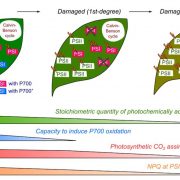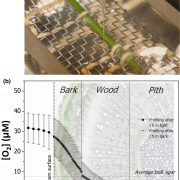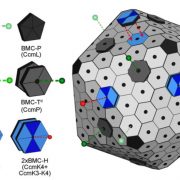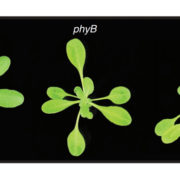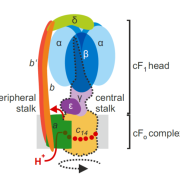Unexpected reversal of C3 versus C4 grass response to elevated carbon dioxide during a 20-year field experiment (Science) $
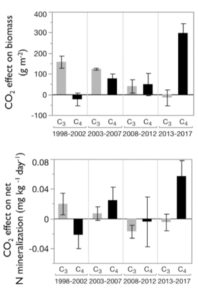 It is widely accepted that the growth of C3 plants responds more to elevated CO2 (eCO2) than that of C4 plants, since photosynthesis in C3 plants is more limited by the current atmospheric CO2:O2 ratio due to the oxygenase activity of Rubisco. This has been established empirically in short-term eCO2 experiments. In this study, Reich et al presented a 20 year field eCO2 experiment consisting of four C3 grass species and four C4 grasses. While C3 biomass responded better to eCO2 earlier in the trial, the C4 biomass response gradually overtook the C3 response towards the end of the trial. The authors present data to suggest that this reversal was not due to changes in leaf level photosynthesis over time, while any associations between eCO2 responsiveness and temperature or rainfall were inconsistent and weak over the trial period. Instead, there was an association between soil net nitrogen mineralisation and biomass for both C3 and C4 species, and this trait differed over time in the C3 and C4 plots. The reason for these differences in soil nitrogen availability remains unexplained, but this study reinforces a need to take a long-term approach to evaluating the effect of eCO2 on crop productivity. (Summary by Mike Page) Science 10.1126/science.aas9313
It is widely accepted that the growth of C3 plants responds more to elevated CO2 (eCO2) than that of C4 plants, since photosynthesis in C3 plants is more limited by the current atmospheric CO2:O2 ratio due to the oxygenase activity of Rubisco. This has been established empirically in short-term eCO2 experiments. In this study, Reich et al presented a 20 year field eCO2 experiment consisting of four C3 grass species and four C4 grasses. While C3 biomass responded better to eCO2 earlier in the trial, the C4 biomass response gradually overtook the C3 response towards the end of the trial. The authors present data to suggest that this reversal was not due to changes in leaf level photosynthesis over time, while any associations between eCO2 responsiveness and temperature or rainfall were inconsistent and weak over the trial period. Instead, there was an association between soil net nitrogen mineralisation and biomass for both C3 and C4 species, and this trait differed over time in the C3 and C4 plots. The reason for these differences in soil nitrogen availability remains unexplained, but this study reinforces a need to take a long-term approach to evaluating the effect of eCO2 on crop productivity. (Summary by Mike Page) Science 10.1126/science.aas9313


